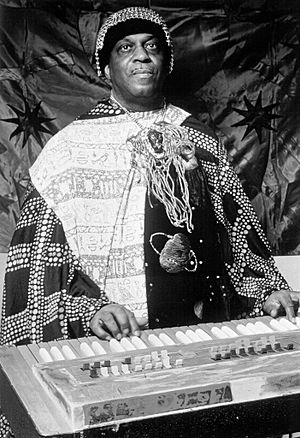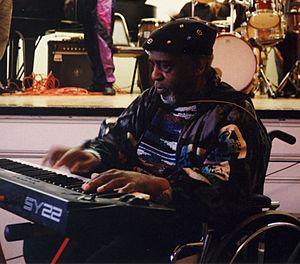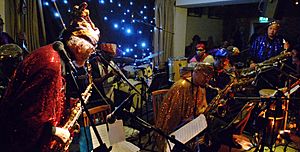Sun Ra facts for kids
Quick facts for kids
Sun Ra
|
|
|---|---|

Sun Ra, c. 1973
|
|
| Background information | |
| Birth name | Herman Poole Blount |
| Also known as | Le Sony'r Ra (legal name) |
| Born | May 22, 1914 Birmingham, Alabama, U.S. |
| Died | May 30, 1993 (aged 79) Birmingham, Alabama, U.S. |
| Genres |
|
| Occupation(s) |
|
| Instruments | Keyboards, vocals |
| Years active | 1934–1993 |
| Labels | El Saturn, Thoth Intergalactic, Impulse!, MPS, ESP-Disk, Black Saint, A&M, Leo, Rounder |
| Associated acts | The Sun Ra Arkestra |
Le Sony'r Ra (born Herman Poole Blount, May 22, 1914 – May 30, 1993), known as Sun Ra, was an American jazz musician. He was a composer, bandleader, and played piano and synthesizer. He was also a poet. Sun Ra was famous for his experimental music, his "cosmic" ideas, and his amazing stage shows.
For most of his career, Sun Ra led a band called "The Arkestra." The band's name and members often changed. Sun Ra was born and grew up in Alabama. He later joined the jazz scene in Chicago in the late 1940s. He soon changed his name to Le Sony'r Ra, or simply Sun Ra. He chose this name after Ra, the ancient Egyptian god of the Sun.
Sun Ra claimed he was an alien from Saturn. He said his mission was to share peace on Earth. He created a unique personality and beliefs. This made him a pioneer of Afrofuturism. He always denied his birth name, saying, "Any name that I use other than Ra is a pseudonym." His music was very varied and avant-garde. It included styles from the entire history of jazz. This ranged from ragtime to free jazz.
From the mid-1950s until he died, Sun Ra led The Arkestra. Famous musicians like Marshall Allen and John Gilmore played in it. Their shows often had dancers and musicians in amazing, futuristic costumes. These outfits were inspired by ancient Egypt and the Space Age. The band is still active today, led by Marshall Allen.
Sun Ra was a very busy recording artist and performer. He recorded over 100 albums and more than 1,000 songs. This makes him one of the most productive artists of the 20th century. He was a pioneer in free improvisation and modal jazz. He also used electronic keyboards and synthesizers very early on.
Contents
Sun Ra's Life Story
Early Years
Herman Blount was born on May 22, 1914, in Birmingham, Alabama. His family nicknamed him "Sonny." He was a very talented pianist as a child. By age 11 or 12, he was already composing music. He could also read music very well.
Birmingham was a popular stop for touring musicians. Young Herman saw many famous artists like Fletcher Henderson and Duke Ellington. In his teenage years, he showed amazing musical skill. He could listen to a big band performance and then write down all the songs from memory.
By his mid-teens, Blount was playing music semi-professionally. He performed alone or with jazz and R&B groups. He went to Industrial High School (now Parker High School). There, he studied music with John T. "Fess" Whatley. Whatley was a strict but respected teacher.
Herman's family was religious, but not part of any church. He was a quiet, kind, and smart student. He loved to read. He often visited the Black Masonic Lodge. This was one of the few places in Birmingham where African Americans could freely access books. Their collection on Freemasonry and other deep ideas greatly influenced him.
Starting His Music Career
In 1934, Blount got his first full-time music job. His high school biology teacher, Ethel Ernestine Harper, formed a band. Blount joined and toured with her group. When Harper left, Blount took over the band. He renamed it the Sonny Blount Orchestra.
The band toured for several months but didn't make much money. Still, they earned good reviews from fans and other musicians. After this, Blount found steady work as a musician in Birmingham. The city's clubs often had colorful lights and murals. Some people think these influenced Sun Ra's later stage shows.
In 1936, Blount received a scholarship to Alabama Agricultural and Mechanical University. He studied music composition and theory. However, he left after one year.
His "Trip to Saturn"
Sun Ra said he left college because of a special experience. He claimed he had a vision in 1936 or 1937. In this vision, he was taken to the planet Saturn. He said aliens told him to share a message of peace.
This story became a big part of his unique personality. He talked about this vision for the rest of his life. It happened before "flying saucers" became famous in the public. This story helped him create his own personal myth.
Chicago Years (1945–1961)
In 1945, Sun Ra moved to Chicago. He quickly found work. He recorded with blues singer Wynonie Harris in 1946. He also played with the Lil Green band. In 1946, he joined Fletcher Henderson's band as a pianist and arranger.
Chicago was a hub for African-American political groups and new ideas. Sun Ra absorbed all of this. He was fascinated by the city's many ancient Egyptian-style buildings. He read books that said ancient Greek ideas came from Egypt. He believed that African history had been hidden by European cultures.
By 1952, Blount was leading the Space Trio. On October 20, 1952, he legally changed his name to Le Sony'r Ra. He felt his birth name was a "slave name." He wanted a new identity.
Later, John Gilmore and Marshall Allen joined his group. They became two of the most dedicated members of The Arkestra. Sun Ra also met Alton Abraham, who became his business manager. Abraham helped book shows and manage the band.
In the mid-1950s, Sun Ra and Abraham started their own record label, El Saturn Records. They released Sun Ra's music. Around this time, Sun Ra and his band began wearing wild, Egyptian or science fiction-themed costumes. These outfits showed his interest in ancient Egypt and the Space Age. They also gave the band a unique look and added fun to their shows.
New York and Philadelphia (1961–1993)
In 1961, Sun Ra and The Arkestra moved to New York City. They lived together to save money. This allowed Sun Ra to call for rehearsals at any time. In 1966, they got a regular gig at Slug's Saloon. This helped them reach new audiences. People from the beat generation and early psychedelia fans loved his music.
In 1968, Sun Ra and the Arkestra moved to Germantown, Philadelphia. They lived in a house that became their main base. It was known as the Arkestral Institute of Sun Ra. Sun Ra became a well-known figure in Philadelphia. He appeared on radio, gave talks, and visited libraries.

In late 1968, The Arkestra toured the US West Coast for the first time. Their shows were huge, with 20–30 musicians, dancers, singers, and special lighting. Sun Ra even appeared on the cover of Rolling Stone magazine in 1969.
Starting in 1970, The Arkestra began touring internationally. They played in France, Germany, and the United Kingdom. Sun Ra continued to play in Europe almost until he died. In 1971, he was an artist-in-residence at the University of California, Berkeley. He taught a course called The Black Man In the Cosmos.
In 1972, Sun Ra and The Arkestra made an 85-minute film called Space Is the Place. It was filmed in Oakland and San Francisco. The Arkestra also appeared on the TV show Saturday Night Live in 1978. They continued touring and recording throughout the 1980s and early 1990s.
Later Life and Death
Sun Ra had a stroke in 1990. But he kept composing and leading The Arkestra. When he became too ill, he asked John Gilmore to lead the band.
In late 1992, Sun Ra moved back to his hometown of Birmingham, Alabama. He lived with his sister, Mary Jenkins. He died in the hospital on May 30, 1993. He was buried in Elmwood Cemetery. His gravestone reads "Herman Sonny Blount aka Le Sony'r Ra."
The Arkestra Band
After Sun Ra passed away, the Arkestra was led by tenor saxophonist John Gilmore. Later, alto saxophonist Marshall Allen took over. The Arkestra still tours and performs today. In 2004, they were the first American jazz band to play in Tuva, Siberia.
They have performed at many festivals and venues around the world. In 2011, they visited Australia for the first time. In 2019, they played three nights at the Hollywood Theater in Portland, Oregon.
Sun Ra's Music Style
Sun Ra's piano playing mixed many styles. He used boogie woogie, stride piano, and blues. He also had a refined touch like Count Basie and sharp, percussive attacks like Cecil Taylor. He was also influenced by classical music. Sun Ra said Chopin, Rachmaninoff, and Shostakovich were his favorite composers.
His music can be generally divided into three periods: Chicago, New York, and Philadelphia. But his records and performances always had surprises.
Musicians in The Arkestra
Many musicians played in Sun Ra's bands over the years. Some stayed for decades, while others played only a few times. Sun Ra often changed the band's lineup himself. If he was unhappy with a musician, he would sometimes just move the band to a new town without telling that person.
Here are some of the musicians who played with Sun Ra or The Arkestra:
- Yahya Abdul-Majid, tenor saxophone (1980–2020)
- Fred Adams, trumpet (1981–?)
- Luqman Ali (Edward Skinner), drums (1960, 1977–?)
- Marshall Allen, alto saxophone, flute, oboe (1957–present)
- Atakatune (Stanley Morgan), percussion (1972–1992)
- Ayé Aton (Robert Underwood), drums and percussion (1972–1976)
- Robert Barry, drums (1955–1968, 1979)
- Ronnie Boykins, double bass (1957–1974)
- Arthur "Jiunie" Booth, double bass
- Darryl Brown, drums (1970–1972)
- Owen "Fiidla" Brown, violin, dance, vocals (1987–1990s and later appearances)
- Tony Bunn, electric bass (1976)
- Francisco Mora Catlett, drums (1973–1980)
- Samarai Celestial (Eric Walker), drums (1979–1997)
- Don Cherry, pocket trumpet (1983–1990)
- Vincent Chancey, French horn (1976–1995)
- Damon Choice, vibraphone (1974–?)
- Phil Cohran, trumpet (1959–1961)
- India Cooke, violin (1990–1995)
- Danny Davis, alto saxophone, flute (1962–1977, 1985)
- Dave Davis, trombone (1997–present)
- Joey DeStefano, alto saxophone (1968–1969)
- Arthur Doyle, saxophone (1968, 1989)
- Bruce Edwards. guitar (1983–1993)
- Eddie Gale, trumpet (1960s)
- Richard Evans, bass (1950s)
- John Gilmore, tenor saxophone, bass clarinet (1954–1964, 1965–1995)
- Kwame Hadi (Lamont McClamb), trumpet, conga, vibraphone (1969–1996)
- Billy Higgins, drums, (1989)
- Tyrone Hill, trombone (1979–present)
- Tommy "Bugs" Hunter, drums, sound engineer (1951–1990)
- Ahmed Abdullah, trumpet, (1976–1993)
- James Jacson, bassoon, oboe, flute, Ancient Egyptian infinity drum (1963–1997)
- Clifford Jarvis, drums, (1961–1976, 1983)
- Donald Jones, drums (1973–1974)
- Dr. VonFiend (musician), various instruments, effects (2006–2009)
- Wayne Kramer, guitar (2006)
- Elson Nascimento, percussion, vocals (1987–present)
- Bob Northern, french horn
- Eloe Omoe, bass clarinet, oboe
- John Ore, double bass
- Taylor Richardson, guitar (1979–1983)
- Pat Patrick, baritone saxophone, alto saxophone, clarinet, flute (1950–1959, 1961–1977, 1985–1988)
- Julian Priester, trombone (1955–1956, 1980s–1990s)
- Rollo Radford, bass
- Knoel Scott, alto saxophone, tenor saxophone, baritone saxophone, singer and dancer (1979–present)
- Buster Smith, drums
- Marvin "Bugalu" Smith, drums
- James Spaulding, alto sax, flute (1959)
- Michael Ray, trumpet (1978–present)
- Pharoah Sanders, saxophone (1964–1965)
- Bill Sebastian, outerspace visual communicator (1978–1980)
- Talvin Singh, tablas
- Alan Silva, double bass, cello, violin (early 1970s)
- Tani Tabbal, drums
- Clifford Thornton, trombone
- June Tyson, singer, violin
Outer Space Visual Communicator
The Outer Space Visual Communicator (OVC) was a large machine. It was played with hands and feet to create light designs. It was like how musicians make sound with their instruments. Sun Ra used the OVC in the Arkestra from 1978 to 1980.
Sun Ra's Unique Ideas
Sun Ra's ideas were often called a philosophy. But he called his own way of thinking an "equation." He said philosophy was based on theories, but his method was based on logic. Many Arkestra members said Sun Ra's teachings were very important to them.
He got ideas from many sources. These included Kabbalah, Rosicrucianism, numerology, and Ancient Egyptian Mysticism. Sun Ra was careful about the Bible. He knew it had been used to justify slavery. He often changed Bible passages to find "hidden" meanings. He also renamed many musicians in his band.
James Jacson, a bassoon player, found similarities between Sun Ra's ideas and Zen Buddhism. Drummer Art Jenkins said Sun Ra's "nonsense" sometimes made him think for days. Then it would lead to a new way of seeing things.
You can learn more about Sun Ra's ideas from his film Space is the Place. The film starts with Sun Ra on a far-off planet. There, the music and feelings are different from Earth. On Earth, the air is full of "guns, anger, and frustration." A colony is built on this new planet just for black people. Sun Ra believed that only on a distant planet could black people truly be free.
His Influence and Legacy
Many of Sun Ra's ideas were new and important. He was one of the first jazz leaders to use two double basses. He also used the electric bass and electronic keyboards. He explored modal music and pioneered freeform improvisations.
He also had a big impact on culture. He said jazz came from Africa. He brought back pride in black history. He also showed the spiritual side of music. These were all key parts of the black cultural movement in the 1960s.
The band NRBQ recorded Sun Ra's song "Rocket #9" in 1968. Sun Ra had given the song to NRBQ's Terry Adams. He told him, "This is especially for you." This inspired Adams to restart his band. NRBQ still plays Sun Ra's songs today. Several Arkestra members have toured with NRBQ.
Detroit's MC5 played some shows with Sun Ra. They were greatly influenced by him. Their 1969 album Kick Out the Jams has a song called Starship. It was based on a poem by Sun Ra.
Sun Ra was added to the Alabama Jazz Hall of Fame in 1979.
In 2022, the building at 5626 Morton Street in Philadelphia was listed as a historic landmark. This building was known as the Arkestral Institute of Sun Ra. Marshall Allen, who played with Sun Ra, has lived there since 1968.
The University of Chicago has a large collection of Sun Ra's works. It also has his personal items. This collection was put together by Sun Ra's business manager, Alton Abraham. It is open to the public.
Music Albums
Films
Space Is the Place (1974) is a movie starring Sun Ra and his band. The film's music was also by Sun Ra. In the movie, Sun Ra returns to Chicago after traveling in space. He makes a deal to "win" the black community. Sun Ra wants to take the American black community to a new planet. He hopes this planet will be a home for only black people. His goal is to "teleport the whole planet through music."
Sun Ra and his Arkestra were also featured in a few documentary films. These include Robert Mugge's Sun Ra: A Joyful Noise (1980). This film showed performances and Sun Ra talking about different topics. Another film, Sun Ra – Brother from Another Planet (2005) by Don Letts, included some of Mugge's material.
See also
 In Spanish: Sun Ra para niños
In Spanish: Sun Ra para niños


